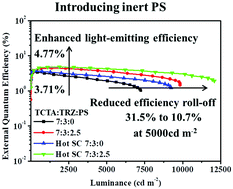Inert polymer modification of an exciplex emitter enhances the light-emitting efficiency and reduces the efficiency roll-off of solution-processed organic light-emitting diodes
Abstract
The introduction of an inert polymer in an exciplex emitter is proposed to fabricate high-performance solution-processed organic light-emitting diodes (OLEDs) employing a thermally activated delayed fluorescence (TADF)-type exciplex emitter. A complex of tris(4-(9H-carbazol-9-yl)phenyl)-amine (TCTA) and 2,4,6-triphenyl-1,3,5-triazine (TRZ) is employed as the exciplex emitter. The photoluminescence spectrum of the TCTA : TRZ complex is slightly blue-shifted and the rate constant of reverse intersystem crossing is increased from 6.4 × 106 s−1 to 7.1 × 106 s−1 by blending with inert polystyrene (PS). The PS in the TCTA : TRZ complex could disperse the exciplex pairs to reduce the concentration quenching. The inert PS located between the donor and acceptor can also increase the donor–acceptor distance and thus increase the reverse intersystem crossing. The hole and electron mobilities of the TCTA : TRZ exciplex emissive layer are more balanced by introducing the inert polymer PS. Consequently, by introducing PS in the exciplex layer, the maximum external quantum efficiency of the devices is increased from 3.71% to 4.77% and the efficiency roll-off is reduced from 31.5% to 10.7% at 5000 cd m−2. This work presents a novel strategy of introducing an inert polymer in a TADF-type exciplex emitter to fabricate high-efficiency and low-efficiency roll-off solution-processed OLEDs.



 Please wait while we load your content...
Please wait while we load your content...